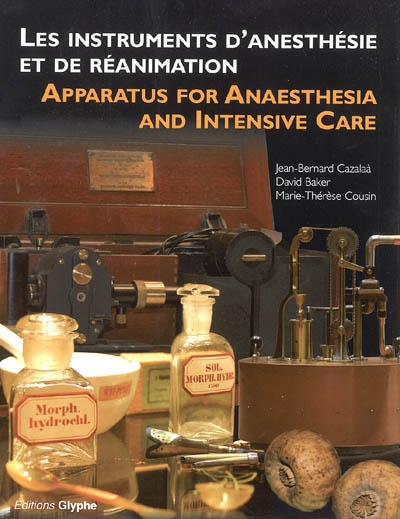en savoir plus

Permet à tous ses détenteurs d'obtenir 5% de réduction sur tous les livres lors du retrait en magasin (réduction non cumulable avec les réductions de type étudiant).
Offre également un certain nombre d'avantages auprès de nos partenaires.
Avec les favoris, retrouvez dans un espace les sélections effectuées au fur et à mesure de vos navigations dans le site.
Constituez pour votre usage personnel vos listes de livres en prévisions d'achats futurs et votre sélection d'articles, dossiers, événements, vidéos ou podcasts préférés ou à découvrir plus tard...
Il suffit simplement de cliquer sur "Ajout Favori" sur chaque page qui vous intéresse pour les retrouver ensuite dans votre espace personnel.
Requiert un compte Mollat
Requiert un compte Mollat
Les instruments d'anesthésie et de réanimation : France, Allemagne et Royaume-Uni (1847-1970). Apparatus for anaesthesia and intensive care : France, Germany and the United Kingdom (1847-1970)
Auteur : Jean-Bernard Cazalaà
Auteur : David Baker
Auteur : Marie-Thérèse Cousin
en savoir plus
Résumé
Rassemble environ 150 appareils exposés durant le World congress of anaestesiologists (2004), qui témoignent de l'histoire de l'anesthésie et de la réanimation et de l'évolution des techniques. Ces appareils étaient conçus pour stocker, administrer et contrôler les effets des substances anesthésiantes. ©Electre 2025
Quatrième de couverture
Les instruments d'anesthésie et de réanimation, 1847-1970
Le 16 octobre 1846, William T. G. Morton, un dentiste, effectuait la première anesthésie générale publique au Massachusetts General Hospital de Boston. Le monde chirurgical changeait d'époque. Finies les douleurs abominables, les exérèses à l'arraché. L'opéré dormirait désormais dans des vapeurs d'éther sulfurique.
Dans le monde entier de nombreux appareils furent inventés et les techniques évoluèrent en fonction des nouveaux anesthésiques et des complications rencontrées. Une véritable saga commençait. L'avènement du « circuit fermé » et de la ventilation artificielle consacra une véritable spécialité médicale et offrit à la narcose un nouveau départ et une sécurité inégalée jusque-là. Quant à l'automatisation et l'électronique, elles étaient encore à venir...
L'ouvrage Les instruments d'anesthésie et de réanimation - France, Allemagne, Royaume-Uni (1847-1970) rassemble plus de cent cinquante appareils exposés durant le World Congress of anaesthesiologists en 2004 à Paris.
Il manquait un véritable panorama du matériel d'anesthésie et de réanimation. Cette collection d'images aidera les étudiants, les spécialistes et les historiens à mieux connaître cette merveilleuse aventure.
Apparatus for anaesthesia and intensive care, 1847-1970
In October 1846, William T.G. Morton, a dentist, performed the first public anaesthesia at the Massachusetts General Hospital in Boston. It was the end of abominable pains and swift excisions. From then on, the patient would sleep under the influence of sulphuric ether.
All over the world, numerous apparatus were invented. The techniques evolved and complications were encountered with the appearance of new anaesthetic agents. A real saga began. Then, closed circuit and artificial ventilation became a real medical specialization, offering narcosis a new start and increasing safety. Automated and electrical devices would come later.
Apparatus for Anaesthesia and Intensive Care - France, Germany, United-Kingdom (1847-1970) gathers more than one hundred and fifty machines presented during the 2004 World Congress of Anaesthesiologists in Paris.
Such a survey of the equipment used in anaesthesia and intensive care is timely. The collection of images, backed up by authoritative texts, will delight students, specialists and historians.
Fiche Technique
Paru le : 02/10/2005
Thématique : Dictionnaires Médecine
Auteur(s) : Auteur : Jean-Bernard Cazalaà Auteur : David Baker Auteur : Marie-Thérèse Cousin
Éditeur(s) :
Ed. Glyphe
Collection(s) : Non précisé.
Contributeur(s) : Préfacier :
Série(s) : Non précisé.
ISBN : Non précisé.
EAN13 : 9782911119682
Reliure : Relié
Pages : 157
Hauteur: 30.0 cm / Largeur 24.0 cm
Poids: 1210 g

